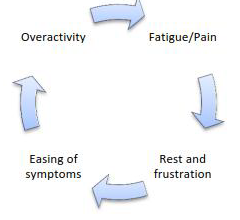|
Many people with a Neurological disorder or Chronic health condition, find that they can no longer do all the activities in a day that they wish. When working with clients we get them to appreciate that they need to pace their activities (Something that over my rehab period I have also had to do). What is Pacing? “a way of increasing your activity level without stirring up your fatigue/pain or other symptoms such as dizziness too much” Aim: to maintain an even level of activity throughout the day instead of doing as much as possible in the morning and then resting all afternoon. When we don't do this we can get in to a cycle which is unproductive which we call the BOOM/BUST cycle. How to use Pacing
1 Work out what you can manage now:
Applying Pacing to a Task – The Rule of the 3 P’s Prioritise Do you need to do the entire task today / in one go? Can you get someone else to help? Does the task need to be done at all? Plan Can you break the job/task into different stages? What do you need to carry out the job? What basic activities does each stage involve? (e.g. walking, sitting, standing) Pace See Pacing Techniques outlined below Pacing Techniques There are 3 main aspects to pacing: 1. Breaking tasks down into smaller bits – Part of prioritising 2. Take frequent short breaks a. Do something for a set time b. This breaks the overactivity / underactivity cycle c. Helps to even out your activity over the course of a day d. ‘Taking a break’ does not mean stopping completely e. Change your position/activity or do something else for a short while 3. Gradually increase the amount you do a. You may seem like you are going backwards and activities can take longer b. Gradually build up the amount you do c. ‘Pace up’ by a set amount d. Do not be tempted to try to do more on a ‘good day’ stick to pacing levels Additional hints for using pacing
Tips for changing habits:
Comments are closed.
|
�
Categories
All
Archives
July 2023
|
|
Contact Us
Give us a call or send us an email to find out how we can help you on your rehab journey Phone 09 424 3254 [email protected] Visit us 3/55 Karepiro Drive, Stanmore Bay, Whangaparaoa |
Cancellation Policy:
Out of courtesy to your therapist, and other clients who may be waiting for an appointment, please inform us of cancellations as soon as possible.
Cancellations Charges: Short notice cancellations within 48 hours of your appointment or reschedules will incur a late cancellation fee of 60%.
For block bookings, one session will be deducted for three cancelled appointments.
Please be aware that ACC does not cover all cancelled appointments.
How to Cancel Your Appointment
If you need to cancel your appointment, please call us at 09 424 3254 between the hours of 8am – 5pm. If necessary, you may leave a detailed voicemail message. We will return your call as soon as possible.
Late Cancellations/No-Shows
A cancellation is considered late when the appointment is cancelled less than 48 hours before the appointed time. A no-show is when a patient misses an appointment without cancelling. In either case, we will charge the patient a 60% missed appointment fee.
Out of courtesy to your therapist, and other clients who may be waiting for an appointment, please inform us of cancellations as soon as possible.
Cancellations Charges: Short notice cancellations within 48 hours of your appointment or reschedules will incur a late cancellation fee of 60%.
For block bookings, one session will be deducted for three cancelled appointments.
Please be aware that ACC does not cover all cancelled appointments.
How to Cancel Your Appointment
If you need to cancel your appointment, please call us at 09 424 3254 between the hours of 8am – 5pm. If necessary, you may leave a detailed voicemail message. We will return your call as soon as possible.
Late Cancellations/No-Shows
A cancellation is considered late when the appointment is cancelled less than 48 hours before the appointed time. A no-show is when a patient misses an appointment without cancelling. In either case, we will charge the patient a 60% missed appointment fee.


 RSS Feed
RSS Feed
